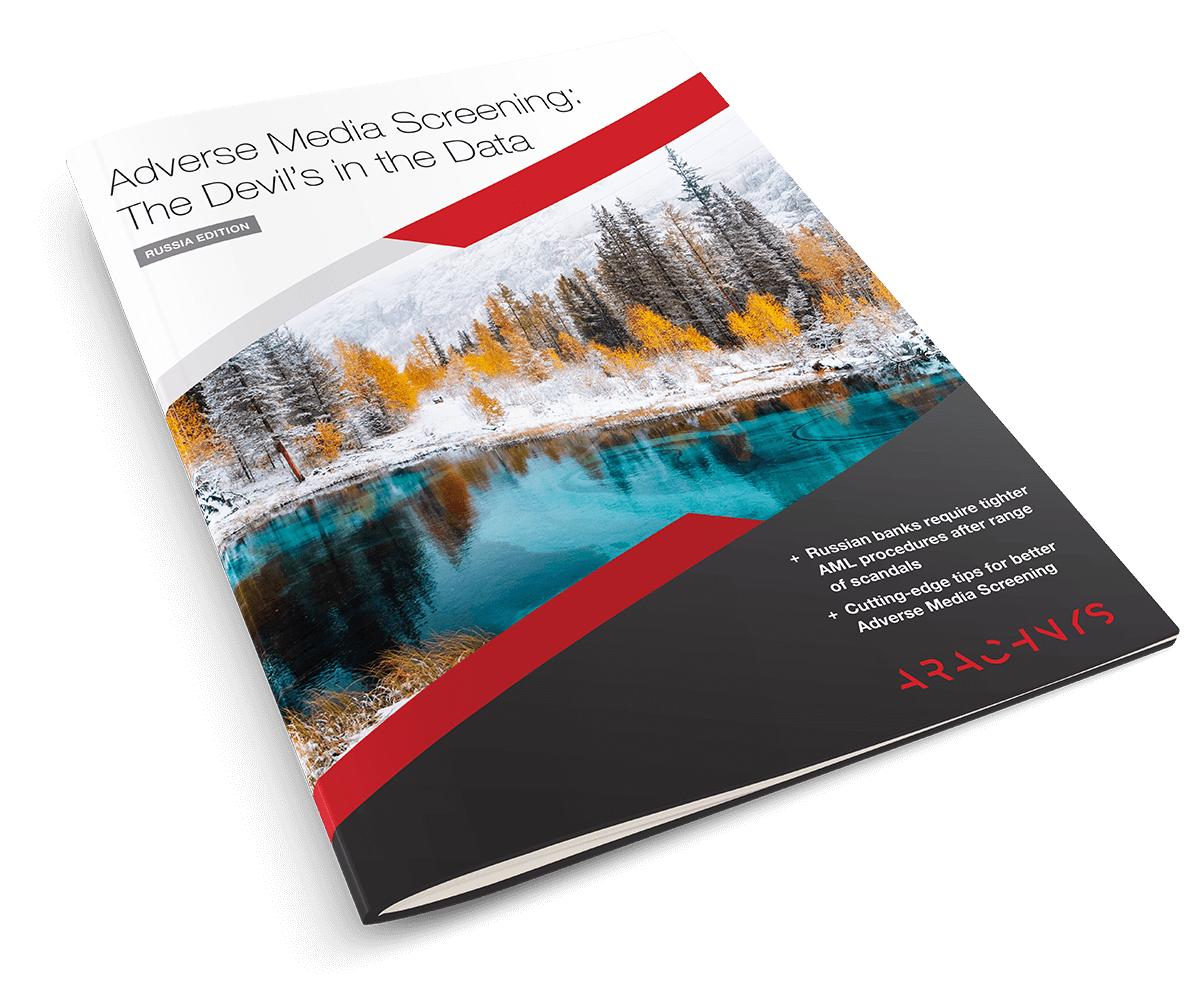
A range of scandals and investigations have highlighted the pressing need for tighter anti-money laundering (AML) procedures in Russian banks, including customer due diligence and adverse media screening.
Although Russia has made some progress on AML, various investigations have alleged the existence of schemes designed to launder billions of dollars out of Russia.
While the government and key players have usually dismissed such allegations, Russia’s Corruption Perception Index (CPI) scores have stayed persistently low in recent years, reflecting a lack of trust in the government’s ability to battle corruption.
This poor perception also extends to many countries in the wider post-Soviet region. The amount of alleged laundering in these countries has prompted the Basel AML Index to introduce a special geographical analysis of ML and terrorist financing (TF) risks. This covers Russia, Lithuania, Armenia, Azerbaijan, Estonia, Georgia, Kazakhstan, Kyrgyzstan, Latvia, Moldova, Tajikistan, Ukraine and Uzbekistan.
Over 60% of those countries – including Russia – are also included in the International Narcotics Control Strategy Report (INCSR) list of major money laundering countries.
‘Top six’ controversy
The international Financial Action Task Force (FATF) sparked controversy in late 2019 when its report on Russia ranked some of the country’s controls against financial crime among the best in the world.
The FATF criticised the AML programmes of many Russian lenders, the level of supervision by Russia’s central bank, and the government’s failure to prosecute individuals suspected of laundering.
But it praised Russia’s efforts in prosecuting terrorist financiers, seizing their assets and co-operating with authorities in other countries. FATF also commended Rosfinmonitoring, the country’s financial intelligence unit, for its analyses of suspicious transactions and sharing of leads with law enforcers.
However, the Basel Institute on Governance (BIG) turns FATF’s qualitative assessments into figures and calculated that the report gave Russia an average 58% rating across AML and CTF effectiveness criteria. This rating puts Russia among the top six countries in terms of effectiveness – after the UK, Israel, the US, Spain and Italy.
This positive assessment has drawn criticism from commentators, including Koos Couvée, Ellen Timmer, and Joshua Kirschenbaum and Jennifer DeNardis.
Tight state control
The ‘top six’ rating might feel wrong given the number of ML investigations and other poor AML assessments of Russia, but it can be explained by FATF’s method.
According to the BIG, the FATF assessment framework does not consider the independence of the judicial system nor the level of political centralisation, political rights and property rights.
Countries with tight state control tend to perform well on AML and CTF effectiveness in the FATF framework. Recent examples include Chinese Taipei (55%), Cuba (48%) and Macao (45%).
With authoritarian state backing, it is no surprise that Russia’s FIU performs well as it is looking at the people the government wants to know about, said BIG.
According to FATF, Russia pursues an average of 52 terrorist financing prosecutions a year – a high rate compared to the number of actual terrorist incidents in Russia, which was 33 in 2018 according to Global Change Data Lab. This effectiveness in one area may therefore skew the overall results, said BIG.
However, the institute also pointed out that some Russian ML scandals happened several years ago and were only discovered and reported recently. They therefore do not account for more recent improvements in the country’s systems.
The right direction
BIG believes Russia is moving in the right direction, as its Basel AML index score hit a record low following the FATF’s December 2019 report. The latest risk score – to be published in 2020 – is 5.60 out of 10, where 10 is the highest assessed risk. In 2019, the figure was 5.75 and in 2014 it was 6.29.
This score puts Russia at 48th out of 125 countries in the BIG money laundering risk table, with first being the highest risk.
The latest IMF Report on Russia, from 2019, also notes that the authorities have made progress in addressing shortcomings in its AML/CTF regime.
For example, the authorities have required all Russian legal entities to have information on beneficial ownership available and make it accurate and up-to-date. The requirement seems to be working well, said the IMF.
Longer-term, Russia has also made considerable progress since 2003, when it was removed from the list of non-cooperative jurisdictions and became a full member of the FATF. This progress includes:
- prohibiting credit institutions from opening and maintaining anonymous accounts
- addressing shortcomings in the reporting and criminalisation of TF
- strengthening measures to freeze terrorist assets.
Stagnating perception
Non-governmental organisation (NGO) Transparency International paints a bleaker picture of corruption in Russia. Its Corruption Perception Index score for Russia is 28 out of 100 – the same score it had in 2012. And, since 2017, it has slipped two places in the world CPI ranking to 137th out of 180.
These continued low scores reflect a lack of trust among experts and businesspeople in the government’s ability to fight corruption. This is unsurprising given the weak political and civil rights, and ineffective system of checks in Russia, said TI.
Cronyism remains a cornerstone of Russian social and political processes. Independent media and NGOs are rare, as they are often replaced with government-backed organisations. The judicial system is often biased, with courts imposing large fines on independent actors to keep them in line with the government’s agenda, said the NGO.
Russia’s ratification on international agreements such as the Criminal Law Convention on Corruption and commitments from the 2016 Anti-Corruption Summit seem to create an illusion of progress in Russia without delivering real results, said TI.
The Council of Europe’s Civil Law Convention on Corruption, which allows citizens and private sector actors to seek redress for corruption cases, remains a non-priority for Russia, as do lobbying regulations and whistleblower protections, it said.
Softening reporting requirements
The 2019 INCSR report on Russia recognised that the country has developed a vast AML/CTF legal framework with Rosfinmonitoring at its centre.
However, it highlighted several weaknesses in supervision, including on reporting related to individuals.
INCSR identified a vast shadow economy in Russia, with criminal proceeds making their way to global financial centres, often through opaque shell companies.
The report also said the Russian government has softened some reporting requirements to shield individuals and entities from the effects of financial sanctions.
For example, politically exposed persons (PEPs) are subject to less stringent reporting requirements for foreign currency transactions; and certain entities are exempt from requirements to disclose beneficial ownership.
Risk-based banking supervision
Sometimes supervision measures need to be prescriptive, for example, in identifying foreign politically exposed persons. At other times, a risk-based approach is more effective, for example, in customer due diligence on other types of customers.
According to FATF, the Bank of Russia (BoR) has implemented some risk-based supervision since 2013, and has recently improved this. Russia also strengthened licensing requirements for financial institutions in 2013, which now largely mitigate the risk of criminals owning or controlling such institutions.
However, supervision is mostly based on prudential factors and the BoR over-relies on remote monitoring. While some licences have been revoked, sanctions are not effective in all cases and monetary penalties imposed are low, said FATF.
Speaking to Arachnys, Richard Gordon, director of the Financial Integrity Institute at Case Western Reserve University, said AML in Russian banks is improving, especially among the larger banks. However, he said smaller institutions have some way to go, largely because supervision of the banking sector is still dominated by the prudential supervisors – who are also trying to keep banks from going bankrupt.
‘These supervisors have not yet given AML enough attention, and in this sense, Russia is behind the curve,’ said Gordon. ‘It needs more dedicated AML/CTF examinations, and they should be on site rather than just remote.’
Russia is also still a bit behind on taking a more risk-based approach to AML, he said.
‘While larger banks do apply risk-based measures, they may be too “tick box”,’ said Gordon. ‘But with not enough dedicated AML/CTF examinations it is hard to know for sure.’
In contrast, the national risk assessment appears good and has exposed the importance of official corruption, he said.
‘It is necessary for this to filter down to the banks and the supervisory levels,’ said Gordon. ‘But Russia is far from alone in facing such challenges.’

Download the white paper
You can download this content plus an additional look at the Arachnys data expertise for the Russia region, as well as some cutting-edge tips for better adverse media screening. Download the PDF from this page.
You can also download our data sheet for Russia.

